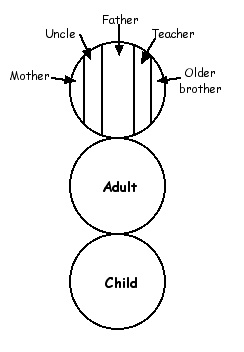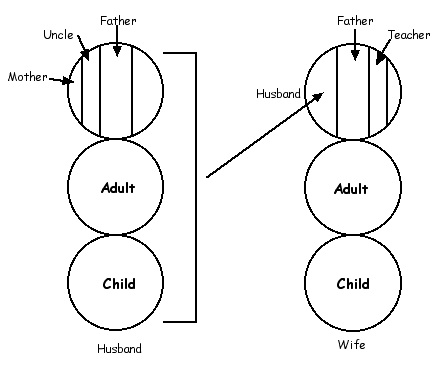It is interesting how at times normal psychological processes can end up being defined as pathological states. The American Psychiatric Association (1994) in the DSM-IV discuss what is known as a Folie a Deux or shared psychotic disorder.
In this case two people who are in a close relationship over time develop the same delusional belief system. This could include a delusion where suicide is seen as the only real solution. Usually there tends to be one dominant party and the more submissive party takes on the delusion of the other. This means that should the relationship end the more submissive party will tend to drop the delusion over time even though the submissive party probably has a tendency to have the same delusional beliefs.
However this happens in every relationship that has an attachment. As I have said before when an attachment develops both parties take on personality characteristics of each other. There is a blurring of their identities and the process of introjection occurs where one literally takes in the personality characteristics of the other.
Transactional Analysis can explain this process at least in part with the development of the Parent ego state. That ego state is merely a collection of parent tapes as they are called and can be drawn as such;

Each person we model off will be incorporated into our Parent ego state. The more emotionally important they are for us the more we will introject them into our Parent ego state. This can occur in a marriage as is shown in the diagram below. Here the wife is incorporating the husband into her own personality.

In this process it is not necessarily equal and the less emotionally potent figure will tend to introject more of the dominant figure than the other way around. This is a natural process that is inevitable. It will occur unconsciously and relentlessly in all significant relationships one has.
If the husband happens to have significant paranoid delusions then we have a Folie a deux with the husband seen as the ‘inducer’ as they are called. If they should separate then the wife’s paranoid delusions will subside over time as her Parent ego state readjusts and the other ‘tapes’ gain more of a presence in her personality or she may even begin incorporating a new partners Parent ego state who is not delusional.
There is nothing odd about this process. We are all doing the same psychological processing everyday. If his wife happens to be of a low self esteem and the husband happens to be a strong character who believes in himself and others then she will tend to take those personality characteristics in as well. Over time she will begin to have a ‘spontaneous recovery’ as it is called. How much that recovery occurs depends on how strong the Child ego state believes she is worthless, the strength and quality of the relationship with the husband, how selective her perception is, other Parent ego state influences in her current life and so forth.

But it is certainly not going to hurt the wife if this situation exists. However what usually tends to happen is people who believe they are of little worth will tend to form relationships with others who also believe they are of little worth. So the wife would be constantly introjecting new Parent ego state tapes that support her self deprecating beliefs.
This introjecting process can manifest in other interesting ways. It is particularly strong with teenagers and why ‘peer pressure’ is particularly important in that stage of development. In childhood it is the parents who dominate the young child’s attachments and thus dominate their introjections and Parent ego state tape incorporation. For a child the mother is the inducer and the child introjects her personality. If the mother has paranoid delusions then they may develop a shared paranoid disorder together.
When the child becomes an adolescent it begins to form strong attachments to others besides the parent, most often its peers. The parents rapidly begin to loose their psychological control over the child because the child is not dependent on them for its primary attachments. It starts developing its primary attachments to its peers.

In addition to this adolescence is when there is a growth spurt of development in the Parent ego state. Parent tape introjections are particularly influential at this point as the teenager’s Parent ego state is immature and very susceptible to influence by tape incorporation. Mothers and fathers realise this at some level and can become quite concerned of the peer pressure that they feel their son may be under. The introjection process is particularly prominent in adolescence.
This same process can also explain how a suicide pact may develop. Just as two people can develop shared paranoid delusions they can also develop shared delusions about all sorts of things including suicide. As they talk about suicide over time their Parent ego states can become more and more similar and thus become more and more supportive of each others beliefs about suicide as a solution to problems. Eventually one can end up with a suicide pact where both parties attempt suicide together. Again teenagers can be particularly susceptible to this as their Parent ego states are immature.
Then we can have the same process in what is called a transference cure in psychotherapy. The introjection process is at times quite prominent in the counselling process. If the therapist and client form a significant attachment then they will of course be introjecting each other into their Parent ego states. In this situation most often it is quite uneven and the therapist is very much the ‘inducer’ with the client doing much more introjecting than the therapist. However it still will occur both ways. Over time the therapist will become one of the client’s Parent ego state tapes.

When this happens you will hear client’s say things like. “I was talking with someone the other day and I suddenly realised that I sounded exactly like you”. Or the client will adopt some behavioural idiosyncrasies of the therapist and maybe adopt some similar dress or other attitudes they have.
This is sometimes called a transference cure. By introjecting the therapist the client is introjecting beliefs that the client is OK, worthwhile and important which the therapist believes. As this new tape becomes more influential in the personality it will dominate more and more and thus the pre-existing tapes which told the client they are bad and worthless will have less impact.
Graffiti
Oh my goodness... that's lovely.
ReplyDeletethis may be due to my poor English but the sentence
ReplyDelete'what usually tends to happen is people who believe they are of little worth will tend to form relationships with others who also believe they are of little worth'
does not make it unambiguous who is of little worth to the folks described in the latter part of the sentence? I guess people (group A) tend to form relationships with those (group B) who think that A are of little value? And the whole context seems to confirm it but in the case I'm wrong please correct me.
You are correct Zbig and my sentence could be interpreted either way.
ReplyDeleteWhat I meant to say was people who are of the life position I-U+ will tend to marry those who are I+U-.
The person feels bad in themself and marries someone who continues to tell them they are bad.
Cheers
Graffiti
Glad you liked the post Roses
ReplyDeleteI can see how expression of identity could be very confusing with such merging personalities. It sounds like object relations where one develops their own potential psycho-dynamic "objects" which supercede the old or negative "objects" with regard to good therapeutic change.
ReplyDeleteShedding skins and making transitions is more than copying hairstyles and body language though.
ken
Interesting. U+I- and U-I+
ReplyDeleteI am definately I-U+. Mrs K, generally I+U- though I would argue with me she is more I+U+
Hey, have you heard of Hogan?
I did 3 questionnaires this week with work and I have 2 hours with a psychologist with the results at the end of the month.
Hi Kahless,
ReplyDeleteWell I think you are definately OK!
I have heard of Hogan but do you mean Hogan from Hogan's heros or Hulk Hogan?
can't wait to get an update on your psych results
Graffiti
Hi Graf,
ReplyDeletethis Hogan
http://www.hoganassessments.com/
I get the results next Tuesday... I will let you know!